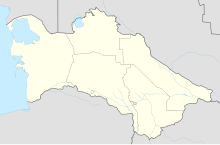Nisa (Parthian)
Coordinates: 37 ° 58 ′ 0 ″ N , 58 ° 11 ′ 42 ″ E
Nisa (Persian Nisā ), also Nesa , Parthaunisa, Mithridakert or Mihrdatkart ( Turkmen Gadymy Nusaý ) in Turkmenistan , 12 km west of Ashgabat , was the first capital of the Parthians . The excavation site has been on the UNESCO World Heritage List since 2007 .
History and structure
The town consisted of New Nisa, the city proper, and old-Nisa with the royal palace, a pentagonal fortress with 5-7 meters high and 8-9 m thick walls of rammed earth ( pachsa ), which were covered with bricks and towers exhibited. Inside were barracks, a round temple (diameter 17 m) and a palace of the dead with square pillared halls around a large central courtyard (38 × 38 m).
The houses in Neu-Nisa had storage facilities and wine cellars with clay jugs ( chum ) dug into the earth . A cemetery was also discovered in New Nisa.
New Nisa was the first place where the Neolithic Jeitun culture was recorded. It was discovered by AA Marushchenko in 1935, and after excavations in Jeitun in 1955, ME Masson defined the corresponding culture. The finds from New Nisa belong to the middle phase of the Jeitun culture.
New Nisa existed well into the Middle Ages, while Old Nisa was abandoned at the beginning of the 3rd century AD.
Exploration and Finds
The city was discovered by Alexander Marushchenko in the 1930s . Systematic excavations have been carried out by the southern Turkmen expedition under Michail Masson since 1946 . Excavations by the University of Turin have been taking place here again since 1990 .
The finds show some strong Hellenistic influence, especially the marble sculptures, while the plaster reliefs are in the typical Parthian style. Numerous larger-than-life clay human figures presumably show Parthian rulers. Among the small finds, seal impressions and animal figures made of precious metal are worth mentioning. Ivory rhyta in the Hellenistic style were figuratively decorated, with ornamental ribbons with scenes from Greek mythology and protomes in the form of winged horses, centaurs, griffins and lions. Approx. 2500 ostraka bear Aramaic characters. These are mostly short economic texts, in particular dated receipts for wine deliveries from the various regions of the Parthian Empire to the royal cellar.
Some of the finds are in the Ashgabat Museum .
literature
- Aleksandr Belenickij: Central Asia . (Archaeologia Mundi) Nagel, Geneva 1968.
- Burchard Brentjes : Central Asia , Koehler and Amelang, Leipzig 1977.
- C. Lippolis: Nisa-Mitradatkert: l'edificio a nord della Sala Rotonda. Rapporto preliminare delle campagne di scavo 2000-2001 , In: Parthic 4 (2002), 47-62.
- Philip L. Kohl: Central Asia: Palaeolithic beginnings to the Iron Age , Paris: Éditions Recherche sur les Civilasations 1984.
- Vadim M. Masson: The Land of a Thousand Cities. Bactria - Khorezmia - Margiane - Parthia - Sogdia. Excavations in the southern Soviet Union. Udo Pfriemer, Wiesbaden / Berlin 1987, pp. 118-139
Web links
- Entry in the UNESCO World Heritage List (English) (French)
- To the more recent excavations in Nisa (in English)
- State committee of Turkmenistan for tourism and sport: Historical site Nissa ( Memento of December 1, 2008 in the Internet Archive )
Individual evidence
- ↑ Kohl 1984, 48








